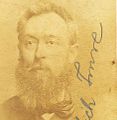Prekmurje Slovenes
This article's factual accuracy is disputed. (February 2011) |
This article may need to be rewritten to comply with Wikipedia's quality standards. (January 2011) |
| Total population | |
|---|---|
| c.110,000+ | |
| Regions with significant populations | |
Calvinist | |
The Prekmurje Slovenes (
Origins
The Prekmurje Slovenes are descendants of the Slovenes of
Middle Ages
The dialect spoken by the Prekmurje Slovenes, in the absence of contacts with other Slovenes, began to diverge from the standard Slovene (Carniolan) dialect. Nevertheless, contacts were maintained with other Slovene areas such as Lower Styria, Maribor, and Ljutomer. In the Middle Ages the Bishopric of Győr applied the name "Tótság" to the Slovene parishes in Vas County, and this name was later also applied to the Slovene areas in Zala County. At that time, ethnic Slovene territory extended to Burgenland and Őrség. In the 12th to 13th centuries, a Slovene community lived near Szentgotthárd Abbey.[3]
From the Protestant Reformation to the 19th century
In the 16th century
In the 16th, 17th, and 18th centuries some of the Mura Slovenes moved to Somogy county.
19th century and Magyarization
In the 19th century part of the policy of Magyarization was to raise the national identity-consciousness of the Prekmurje Slovenes, but by means of the Non-Slovene theory (the Wendish question). The theory, which was supported by Hungarians, was that the Wends (Prekmurje Slovenes) are a "Slavic-Magyar people", and in the long run the support for the Prekmurje dialect and culture is unnecessary as these "Slavic-Magyars" would become entirely Magyarized.
1918–1991
By the
After 1945 the Yugoslav government tried to suppress József Klekl's ideas. In Hungary too not only the Prekmurje Slovene identity was suppressed, but Slovene national identity in general.
The theories of Sándor Mikola
After World War I the "Wendish-Celtic" and "Wendish-Magyar" theories were elaborated by Sándor Mikola. These were based on a falsification of the history of Prekmurje. Slovene sources have said that Mikola claimed that the Prekmurje Slovenes (Wends) are a separate nation, but in fact Mikola denied that there is such a thing as a Prekmurje Slovene identity. In his opinion the Prekmurje Slovenes are a Hungarian group and they "will become Hungarians."
The Mura Republic and Slovenska krajina
In 1918 Klekl sought to establish an autonomous territory, the "Slovenska krajina" (or Slovene March) within Hungary.[7] However, there was little support in Ljubljana for this idea and he later proposed that the Slovene March become an independent state, confederated with Yugoslavia. Later Klekl regretted, that the idea of the Slovene krajina was not pursued. On 29 May 1919 Vilmos Tkálecz declared the Mura Republic (Murska republika, Respublika Mürska)in Murska Sobota, but this had little impact as well.
Since 1991
After 1991 the writer Feri Lainšček[8][9] and others[10] championed the concept of a Prekmurje Slovene identity[11] (panonskoslovenska identiteta).[12] Another advocate of a Prekmurje Slovene identity, Evald Flisar, has written: The homeland regards Prekmurje not as a part of Slovenia but something peculiar within its borders… It is unthinkable for two people from Prekmurje to speak with each other in anything but the Prekmurje dialect. I used to meet the former President of the Republic Milan Kučan at public events quite often. We always spoke the local dialect, it would have felt odd to use standard Slovenian, since he is from Prekmurje too. Others joked about us, asking why are we so secretive. When I met a compatriot in Australia, Africa or America, we immediately started to talk in our own language. This is our language.[13]
Notable people of Prekmurje Slovenes
-
József Borovnyák, politician and writer
-
Imre Agustich, journalist
-
Ferenc Ivanóczy, politician
-
Ágoston Pável, linguist and scientist
-
József Klekl, politician
-
József Szakovics, writer
-
Vilko Novak, historian and scientist
-
Ludvik Vrečič, painter
-
Miško Kranjec, writer
-
Ferdo Godina, writer
-
Anton Vratuša, politician and scientist
-
Miki Muster, sculptor, illustrator, cartoonist
-
Republic of Slovenia
-
Vlado Kreslin, singer-songwriter and musician
-
Evald Flisar, writer
-
Keith Jarrett, jazz pianist and composer
-
Feri Lainšček, writer and poet
-
Nika Zorjan, singer
-
lesbianactivist
Literature
- Jože Alojz and Janez Sraka: Prekmurci in Prekmurje, Chicago 1984.
- Franci Just: Med verzuško in pesmijo, Poezija Prekmurja v prvi polovici 20. stoletja, Franc-Franc, ISBN 961-219-025-9
- Peter Štumpf: Jožef Klekl st., ISBN 961-211-373-4
- Franci Just: Besede iz Porabja, besede za Porabje, Franc-Franc ISBN 961-219-070-4
- Franci Just: Med verzuško in pesmijo, Poezija Prekmurja v prvi polovici 20. stoletja, Franc-Franc, Murska Sobota 2000. ISBN 961-219-025-9
- Klekl József plébános emlékiratai (Szombathelyi levtár)/Memoirs of József Klekl (Archives of Szombathely)
- Predgovor. Nouvi Zákon Stevan Küzmics, Pokrajinski Muzej Murska Sobota 2008. ISBN 978-961-6579-04-9(English translation: Peter Lamovec)
References
- ^ Matija Slavič: Prekmurje, 1921.
- ISBN 963-7206-62-0
- ^ Mukicsné Kozár Mária/Marija Kozar Mukič: Etnološka topografija slovenskega etničnega ozemlja – 20. stoletje; Slovensko Porabje/A szlovén etnikai terület néprajzi topográfiája – 20. század; Szlovénvidék, Ljubljana-Szombathely 1984. 85. pg.
- ^ Predgovor, Nouvi Zákon 2008. 72. pg.
- ISBN 978-961-6579-04-9
- ^ "Göncz László: Muravidék 1919". Archived from the original on 21 July 2011. Retrieved 13 February 2011.
- ^ Tengely Adrienn: Az egyházak és a nemzetiségi kérdés 1918-ban
- ^ Feri Lainšček: V resnici zelo malo pišem (siol.net) Archived 14 February 2011 at the Wayback Machine
- ^ Feri Lainšček, pisatelj in pesnik (mladina.si)
- ^ "Zame prekmurščina ni narečje, temveč jezik" (vecer.com)
- ^ Ábrahám Barna: Magyar-németek, tótok, szlovjákok, magyar oroszok, vendek – népnév és identitás a 19. században
- ^ Dane podatke o življenju in delu Ferija Lainščka uredi v smiselno besedilo
- ^ Nagy Világ, 2007. október


















